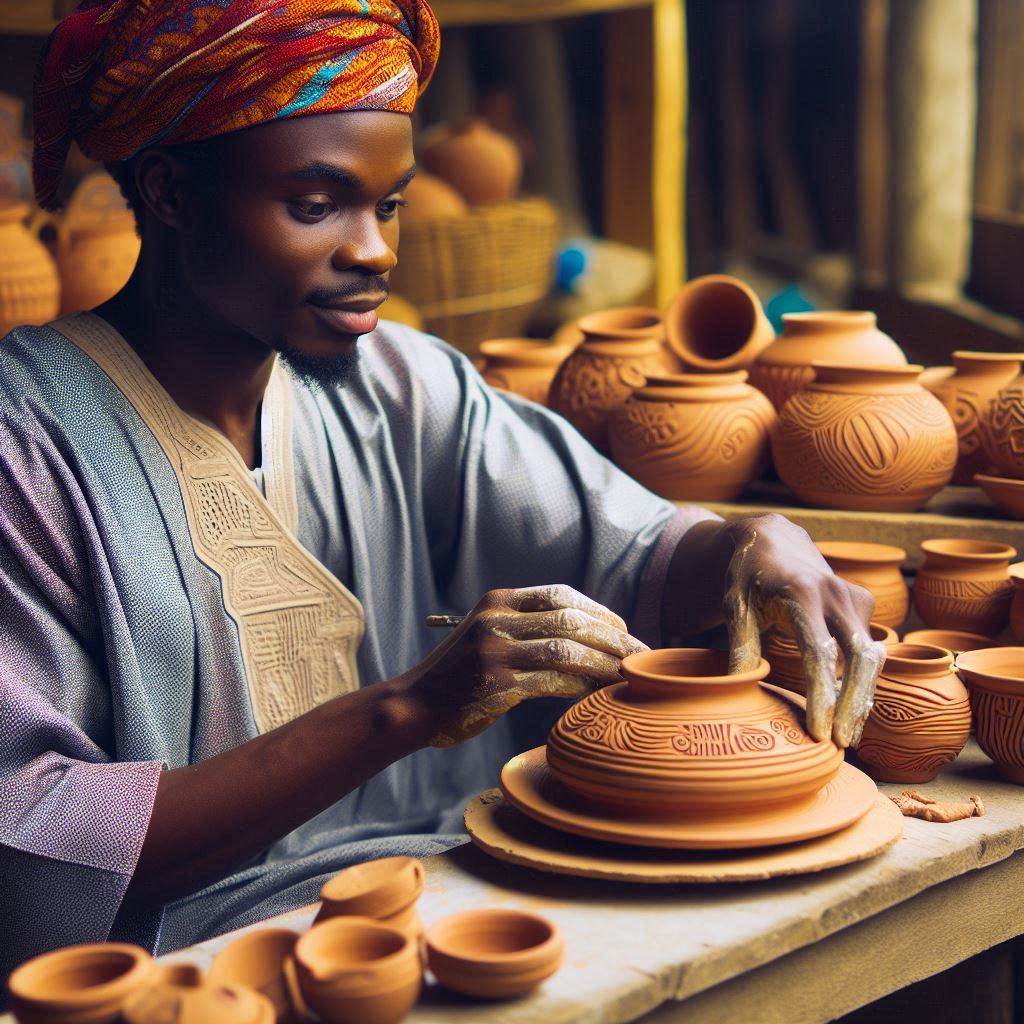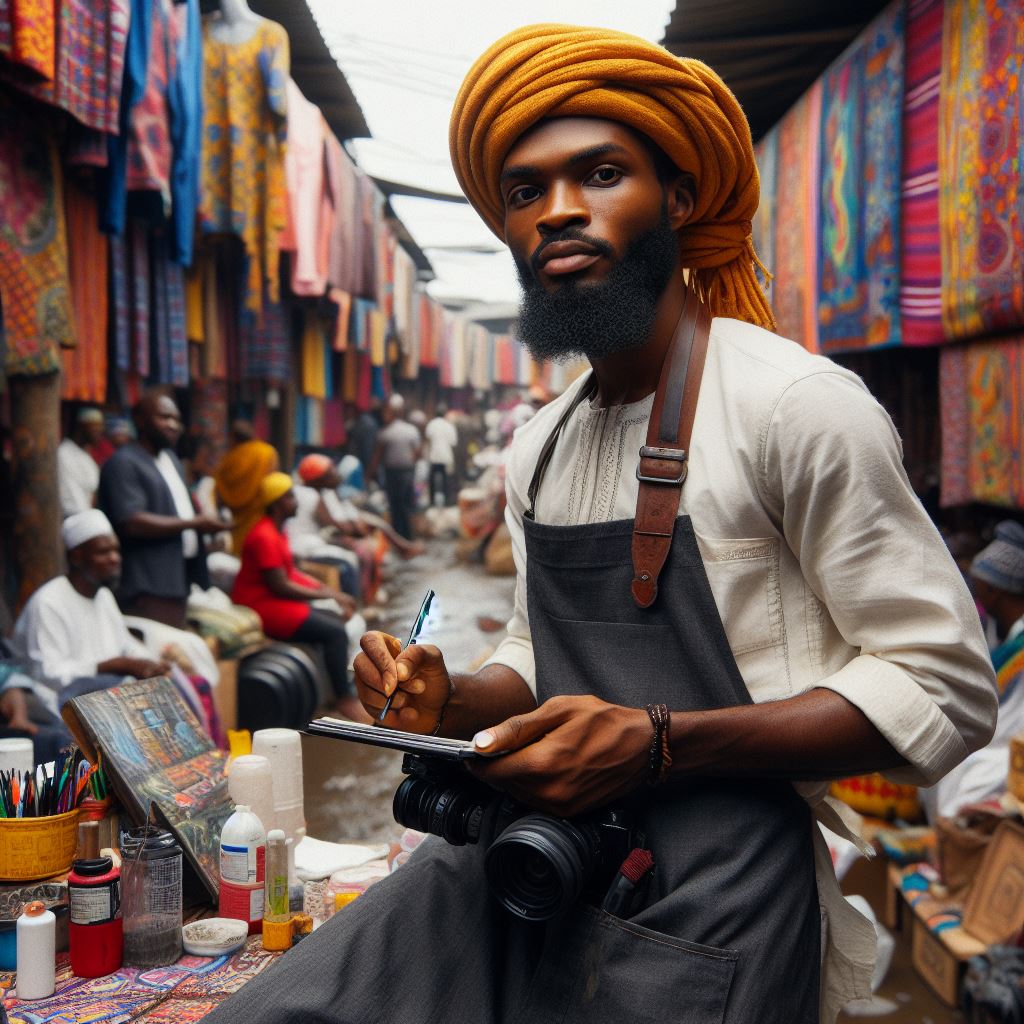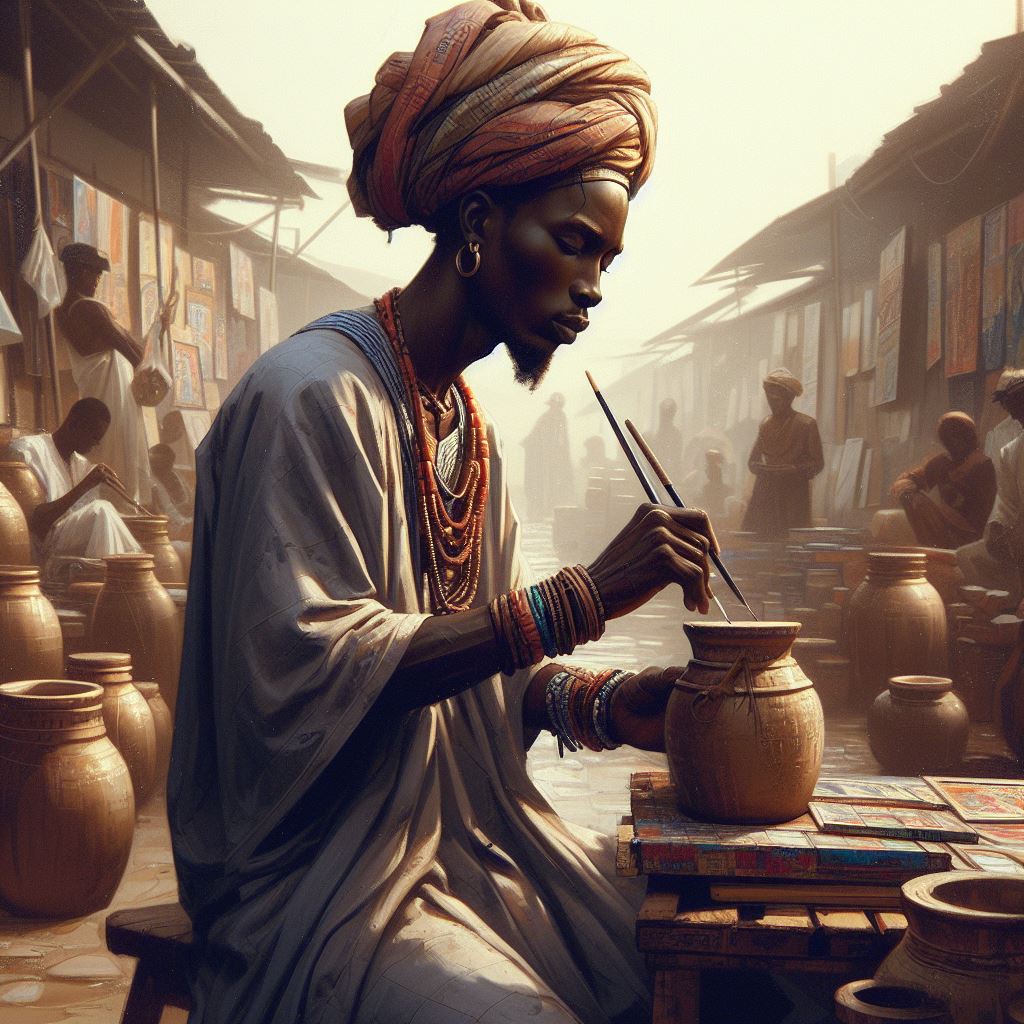Introduction
When it comes to ceramics in Nigeria, the art form has a rich and diverse history. Traditional techniques have been passed down through generations, showcasing the country’s cultural heritage.
Traditional techniques play a crucial role in Nigerian ceramics as they preserve the country’s artistic traditions and craftsmanship.
These methods are often rooted in local customs and practices, making them unique to specific regions.
On the other hand, modern techniques have been introduced to the Nigerian ceramics scene, bringing innovation and contemporary flair to the art form.
These methods often incorporate new tools, materials, and technology to enhance the creative process.
Importance of traditional and modern techniques in Nigerian ceramics
Both traditional and modern techniques are essential in Nigerian ceramics for different reasons.
Traditional methods serve as a link to the country’s past, honoring its cultural identity and heritage. They highlight the skill and artistry of Nigerian artisans who have mastered these techniques over centuries.
On the other hand, modern techniques help push the boundaries of Nigerian ceramics, allowing artists to experiment with new forms, styles, and concepts.
They bring a fresh perspective to the traditional art form, opening up new possibilities for creativity and innovation.
By combining traditional and modern techniques, Nigerian ceramic artists can create unique and dynamic pieces that blend the country’s rich cultural heritage with contemporary aesthetics.
This fusion of old and new techniques not only enhances the art form but also showcases the evolution and versatility of Nigerian ceramics.
Traditional Nigerian Ceramics Techniques
History of traditional ceramics in Nigeria
The history of traditional ceramics in Nigeria dates back to ancient times when pottery was used for various purposes.
Pottery artifacts discovered in archaeological sites across Nigeria provide evidence of the long-standing tradition of ceramics in the region.
In the past, Nigerian potters created functional vessels for daily use, as well as decorative items for ceremonial and religious purposes.
Materials used in traditional Nigerian ceramics
Nigerian potters traditionally use locally sourced materials such as clay, sand, water, and organic materials like plant fibers or residues.
Clay is a primary component in Nigerian ceramics, as it is readily available in various regions of the country and offers unique properties for pottery making.
The choice of clay varies depending on the desired characteristics of the final product, such as color, texture, and durability.
Organic materials like plant fibers are added to clay to enhance its plasticity and prevent cracking during the drying and firing process.
Techniques such as hand-building and coiling
Hand-building and coiling are two of the most common techniques used in traditional Nigerian ceramics to create pottery forms.
Hand-building involves shaping clay by hand without the use of a potter’s wheel, allowing for greater control over the final design and texture.
Coiling, on the other hand, involves rolling out long coils of clay and stacking them on top of each other to build up the walls of a vessel.
Nigerian potters often combine hand-building and coiling techniques to create intricate designs and patterns on their pottery pieces.
Cultural significance of traditional ceramics in Nigeria
Traditional ceramics play a significant role in Nigerian culture, as pottery has been a part of daily life, rituals, and traditions for generations.
Pottery making is not only a practical skill but also a form of artistic expression that reflects the cultural heritage and identity of various Nigerian tribes.
Ceramic vessels are used in ceremonies, festivals, and special occasions as symbols of status, wealth, and spiritual beliefs in Nigerian society.
The intricate designs and motifs found on traditional Nigerian ceramics often carry symbolic meanings related to fertility, protection, and ancestral worship.
Read: Communication Arts: Balancing Theory and Practice
Modern Nigerian Ceramics Techniques
Introduction of modern techniques in Nigerian ceramics
Ceramics in Nigeria have evolved from traditional methods to incorporate modern techniques.
These innovations have transformed the field, offering new possibilities for artists and artisans.
Influence of technology on modern ceramics
Technology has played a significant role in shaping modern ceramics in Nigeria.
Advancements in kiln technology and glazing techniques have improved the quality of ceramic products.
Use of machinery and equipment in modern ceramics
Modern Nigerian ceramic artists now utilize machinery and equipment to streamline production processes.
This allows for greater precision and efficiency in creating ceramic pieces.
Contemporary designs and styles in modern Nigerian ceramics
Contemporary designs and styles have become more prevalent in modern Nigerian ceramics.
Artists are experimenting with new forms, colors, and textures, pushing the boundaries of traditional ceramic art.
Read: How to Apply for Communication Arts Programs
A Comparison of Traditional and Modern Nigerian Ceramics Techniques
Contrasting features of traditional and modern techniques
- Traditional Nigerian ceramics techniques involve hand-building methods such as coiling and pinching.
- Modern techniques, on the other hand, utilize equipment like pottery wheels and kilns for mass production.
Advantages and disadvantages of each approach
- Traditional techniques allow for unique, handcrafted pieces with cultural significance.
- However, modern techniques enable faster production and consistency in quality but may lack individuality.
Impact on the quality and aesthetics of ceramics products
- Traditional techniques often result in irregular shapes and textures, adding character to the pottery.
- In contrast, modern techniques produce more uniform and smooth surfaces, suitable for contemporary designs.
The blend of traditional and modern techniques in Nigerian ceramics
- Some Nigerian ceramists combine traditional techniques with modern tools to create innovative designs.
- This fusion of old and new methods results in pieces that preserve tradition while appealing to modern tastes.
Read: Famous Nigerian Alumni of Communication Arts Programs

Challenges Faced in Preserving Traditional Ceramics Techniques
Preserving traditional ceramics techniques in Nigeria is essential for cultural continuity and heritage preservation. However, there are several challenges that hinder this process
Threats to the Continuity of Traditional Techniques
One of the biggest challenges in preserving traditional ceramics techniques in Nigeria is the threat posed by modernization and industrialization.
As urbanization increases and globalization takes hold, traditional methods are being pushed to the sidelines.
Additionally, the influx of mass-produced ceramics products from other countries often leads to a preference for cheaper and more easily accessible alternatives, further diminishing the demand for traditional techniques.
Loss of Indigenous Knowledge and Skills
Another significant challenge is the loss of indigenous knowledge and skills passed down from generation to generation.
As older practitioners retire or pass away, there is a risk of valuable techniques and practices being lost forever.
Many young Nigerians are not learning traditional ceramics techniques due to a lack of apprenticeships or formal education in this field, leading to a decline in expertise and a widening skills gap.
Lack of Interest Among Younger Generations
There is a growing disconnect between younger generations and traditional ceramics techniques in Nigeria.
With the rise of digital technology and social media, many youths are more interested in modern forms of art and entertainment.
Traditional ceramics may be seen as outdated or less profitable compared to contemporary art forms, leading to a decline in interest and participation in traditional practices among the youth.
Efforts to Preserve and Promote Traditional Techniques
Despite these challenges, there are ongoing efforts to preserve and promote traditional ceramics techniques in Nigeria:
Transform Your Career with Expert Guidance
Get personalized mentorship consulting that’s tailored to your unique path. Our expert advice is actionable and exclusive.
Get Started- Establishment of cultural centers and museums dedicated to showcasing traditional ceramics
- Organizing workshops, seminars, and training programs to educate the public about traditional techniques
- Collaborating with local communities and artisans to document and preserve indigenous knowledge
- Engaging with schools and universities to incorporate traditional ceramics into academic curricula
- Encouraging market demand for traditional ceramics through exhibitions, fairs, and marketing campaigns
By raising awareness, providing educational opportunities, and supporting local artisans, it is possible to revitalize and sustain traditional ceramics techniques in Nigeria for future generations to appreciate and continue.
Preserving this cultural heritage is not only important for maintaining a sense of identity and pride but also for fostering creativity, innovation, and sustainability in the field of ceramics.
Read: Communication Arts: Job Prospects and Salaries
Find Out More: Arabic Language Proficiency Exams in Nigeria
Uncover the Details: Introduction to Anthropology: Basics and Importance
Innovations and Trends in Nigerian Ceramics
Exploration of New Materials and Techniques
Nigerian ceramic artists have been pushing the boundaries of their craft by experimenting with new materials.
These artists are not afraid to think outside the box and explore innovative techniques that set their work apart.
From incorporating locally sourced clays to experimenting with unconventional firing methods, the possibilities are endless.
This exploration of new materials and techniques has led to a renaissance in Nigerian ceramics, attracting attention both locally and internationally.
Integration of Traditional Motifs in Modern Designs
One of the defining characteristics of Nigerian ceramics is the seamless blend of traditional motifs with modern design aesthetics.
By incorporating elements from their rich cultural heritage, Nigerian artists create pieces that are both visually striking and culturally significant.
This fusion of traditional and modern styles has garnered a lot of attention from collectors and art enthusiasts alike.
It serves as a reflection of Nigeria’s vibrant artistic landscape and its ability to evolve with the times.
Collaboration with International Artists and Designers
Nigerian ceramic artists have been collaborating with their counterparts from around the world to exchange ideas and techniques.
These collaborations have resulted in a cross-pollination of artistic styles and a merging of cultural influences.
By working together, artists are able to create pieces that are truly unique and celebrate the diversity of the ceramic arts.
This collaboration with international artists and designers has helped Nigerian ceramics gain recognition on a global scale.
Rising Popularity of Nigerian Ceramics on the Global Stage
In recent years, Nigerian ceramics have been gaining popularity on the global stage, attracting collectors and enthusiasts from all over the world.
The unique blend of traditional Nigerian craftsmanship and modern design sensibilities has captured the attention of the international art community.
With growing recognition and appreciation for their work, Nigerian ceramic artists are now seen as pioneers in the field.
The global success of Nigerian ceramics serves as a testament to the creativity and ingenuity of the artists behind these beautiful pieces.
Gain More Insights: Top Nigerian Universities Offering Music Programs
Uncover the Details: Skills Needed for a Mass Communication Career Nigeria
Uncover the Details: Scholarship Options for Language Studies in Nigeria
You Might Also Like: Top Nigerian TV Shows You Need to Watch Now
The Future of Nigerian Ceramics
In recent years, the ceramics industry in Nigeria has shown significant potential for growth and development.
With the abundance of raw materials such as clay and kaolin, there is a strong foundation for the industry to thrive.
Moreover, the traditional techniques passed down through generations serve as a strong base for innovation and creativity in modern ceramic practices.
The fusion of traditional and modern techniques can lead to unique and diverse ceramic creations.
Potential for Growth and Development in the Ceramics Industry
- Nigeria has a rich history of ceramic art, with unique styles and techniques that make it stand out globally.
- The demand for ceramics in both local and international markets presents lucrative opportunities for Nigerian artisans.
- Investment in infrastructure, technology, and marketing can further boost the growth of the ceramics industry in Nigeria.
Role of Education and Training in Sustaining Ceramic Traditions
- Education plays a crucial role in preserving traditional ceramic techniques and passing them on to future generations.
- Training programs and workshops can help artisans refine their skills and adapt to modern trends in ceramic art.
- Collaborations with educational institutions can provide access to resources and knowledge that can enhance ceramic practices in Nigeria.
Opportunities for Innovation and Creativity in Nigerian Ceramics
- Nigerian artisans have the opportunity to experiment with new techniques and materials to create innovative ceramic pieces.
- Exploring themes that reflect Nigerian culture and traditions can add a unique touch to ceramic artistry.
- The use of technology, such as 3D printing, opens up new possibilities for creativity and design in ceramics.
Therefore, the future of Nigerian ceramics is bright with potential for growth and development.
By upholding traditional techniques through education and training, artisans can sustain the rich ceramic traditions of Nigeria while embracing opportunities for innovation and creativity.
With a blend of old and new practices, Nigerian ceramics can continue to thrive in the global market.
See Related Content: Popular Mass Communication Alumni in Nigeria
Uncover the Details: Top Nigerian Universities for Mass Communication
Learn More: Postgraduate Programs in Arabic Studies Nigeria
Conclusion
Traditional and modern techniques in Nigerian ceramics are vital for preserving cultural heritage and fostering innovation.
Traditional methods showcase Nigeria’s rich history and craftsmanship, reflecting deep cultural significance and time-honored skills.
Modern techniques bring innovation and global appeal, blending old and new to create unique and contemporary works.
Preserving and promoting Nigerian ceramic heritage is crucial for maintaining cultural identity.
Support local artisans by visiting exhibitions, purchasing their works, and sharing their stories.
Encourage educational institutions to teach both traditional and modern ceramic techniques.
This will ensure the continuity and evolution of this rich art form.
The potential for Nigerian ceramics to thrive in the future is immense.
With proper support and promotion, Nigerian ceramics can gain international recognition and compete globally.
By embracing both tradition and innovation, Nigerian ceramic artists can continue to create exceptional works that captivate audiences worldwide.
Let’s celebrate and elevate Nigerian ceramic artists, securing their place on the global stage.
Your support can help preserve this rich heritage and foster new creative expressions.
Together, we can ensure that Nigerian ceramics continue to flourish and gain the international acclaim they deserve.




